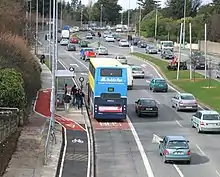Quality Bus Corridor
Quality Bus Corridors (QBC, Irish: Mórlána Bus) are an initiative to give dedicated road space and traffic signal priority to buses in Dublin, Ireland in order to reduce journey times and improve service consistency. The aim of the initiative is to encourage people to change from cars to buses and thus reduce traffic congestion. The strategy requires close co-ordination between the local authorities, who are responsible for the road changes required, and Dublin Bus who operate the vast majority of bus services. This co-ordination is managed by the National Transport Authority.
The idea for the creation of QBCs first arose back in 1993 when Dublin Bus launched its "CitySwift" service on route 39 to Clonsilla along the Navan Road. This became part of the eventual Blanchardstown QBC some years later.
There are currently sixteen QBCs in Dublin. A 2007 survey by the former Dublin Transportation Office found that bus average journey times in the morning peak were less than the corresponding car average journey times in twelve out of the sixteen QBCs monitored, with it being twice as fast in some cases.[1]
The sixteen Quality Bus Corridors are as follows:
- Ballymun QBC
- Blanchardstown QBC
- Bray QBC
- Clontarf QBC
- Crumlin Road QBC
- Finglas QBC
- Howth Road QBC
- Lucan QBC
- Malahide QBC
- North Clondalkin QBC
- Rathfarnham QBC
- Rock Road QBC
- South Clondalkin QBC
- Stillorgan QBC
- Swords QBC
- Tallaght QBC
According to the Dublin Transportation Office (now part of the National Transport Authority (Ireland)), the number of cars entering Dublin's inner city at the canal cordon points reduced by 7849 (21.43%) from November 1997 to November 2004. Conversely the number of bus passengers entering the inner city increased by 15016 (49.17%) during the same period. However between 2003 and 2004 there was a reduction in bus passengers entering the inner city of 7.10%. In part this may be attributable to the introduction of the Luas system, but an increase in car traffic of 5.74% was also noted.
The effectiveness of the QBCs are compromised at various pinch points along the routes. In particular, the routing of the majority of buses on the Lucan routes through Lucan and Chapelizod villages at peak mean that time savings can be frittered away on narrow congested streets filled with school traffic.
In November 2012, three QBCs (Swords, Blanchardstown and Tallaght) were designated for a potential upgrade to bus rapid transit status under the name Swiftway. Public consultation on this matter was carried out during February and March 2014. However, this project didn't not progress past this stage. Instead of providing a bus rapid transit service on just 3 QBCs, it was decided that all 16 QBCs would be upgrades to CBCs or Core Bus Corridors and all 16 would be given bus priority for their entire length through bus lanes, bus gates and other priority measure. On 29 May 2017, a new BusConnects plan was launched, with €1 billion being spent over a ten-year period. It involves the implementation of next generation bus corridors with high quality cycling infrastructure, a redesign of the bus route network and a state-of-the-art, cashless ticketing system.[2] Planning permission will be submitted to An Bord Pleanála in 2020. The service is expected to be fully operational by 2027.
